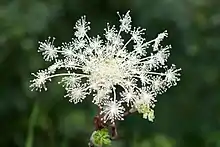| Angelica pubescens | |
|---|---|
 | |
| Scientific classification | |
| Kingdom: | Plantae |
| Clade: | Tracheophytes |
| Clade: | Angiosperms |
| Clade: | Eudicots |
| Clade: | Asterids |
| Order: | Apiales |
| Family: | Apiaceae |
| Genus: | Angelica |
| Species: | A. pubescens |
| Binomial name | |
| Angelica pubescens | |
| Synonyms | |
|
Angelica polyclada Franch. | |
Angelica pubescens is a plant in the family Apiaceae, native to Japan and China. The Japanese common name is shishiudo and the Chinese common name is 猪独活, du huo.
It is a herbaceous perennial plant growing to 1–2 m tall with tripinnate leaves up to 1 m long, the leaflets being 5–10 cm long. The flowers are white, produced in large umbels.
The young stems and leaves are edible. Shishiudo is often mistaken with udo. The plant is used in traditional Chinese medicine.[1]
References
- ↑ Chen, Yuh-Fung; Tsai, Huei-Yann; Wu, Tian-Shung (February 1995). "Anti-Inflammatory and Analgesic Activities from Roots of Angelica pubescens". Planta Medica. 61 (1): 2–8. doi:10.1055/s-2006-957987. ISSN 0032-0943. PMID 7700984.
This article is issued from Wikipedia. The text is licensed under Creative Commons - Attribution - Sharealike. Additional terms may apply for the media files.